Designing and Reflecting on a Lesson Plan for Grade 10 English
VerifiedAdded on 2023/06/18
|11
|2868
|168
Report
AI Summary
This assignment presents a lesson plan designed for a Grade 10 English class, focusing on sources of information and extracting information from texts. The lesson plan includes various activities such as a warming-up word bingo game, a digital story introduction, text reading, group tasks, and individual assignments, followed by homework. A detailed reflection using Gibbs' model examines the experience of designing and implementing the lesson plan, covering aspects like description, feelings, evaluation, analysis, conclusion, and action plan. The reflection highlights the effectiveness of the activities in engaging students, identifies areas for improvement, and outlines strategies for future lesson planning, emphasizing the importance of incorporating fun activities to activate students' interest and participation.

Reflection
Paraphrase This Document
Need a fresh take? Get an instant paraphrase of this document with our AI Paraphraser
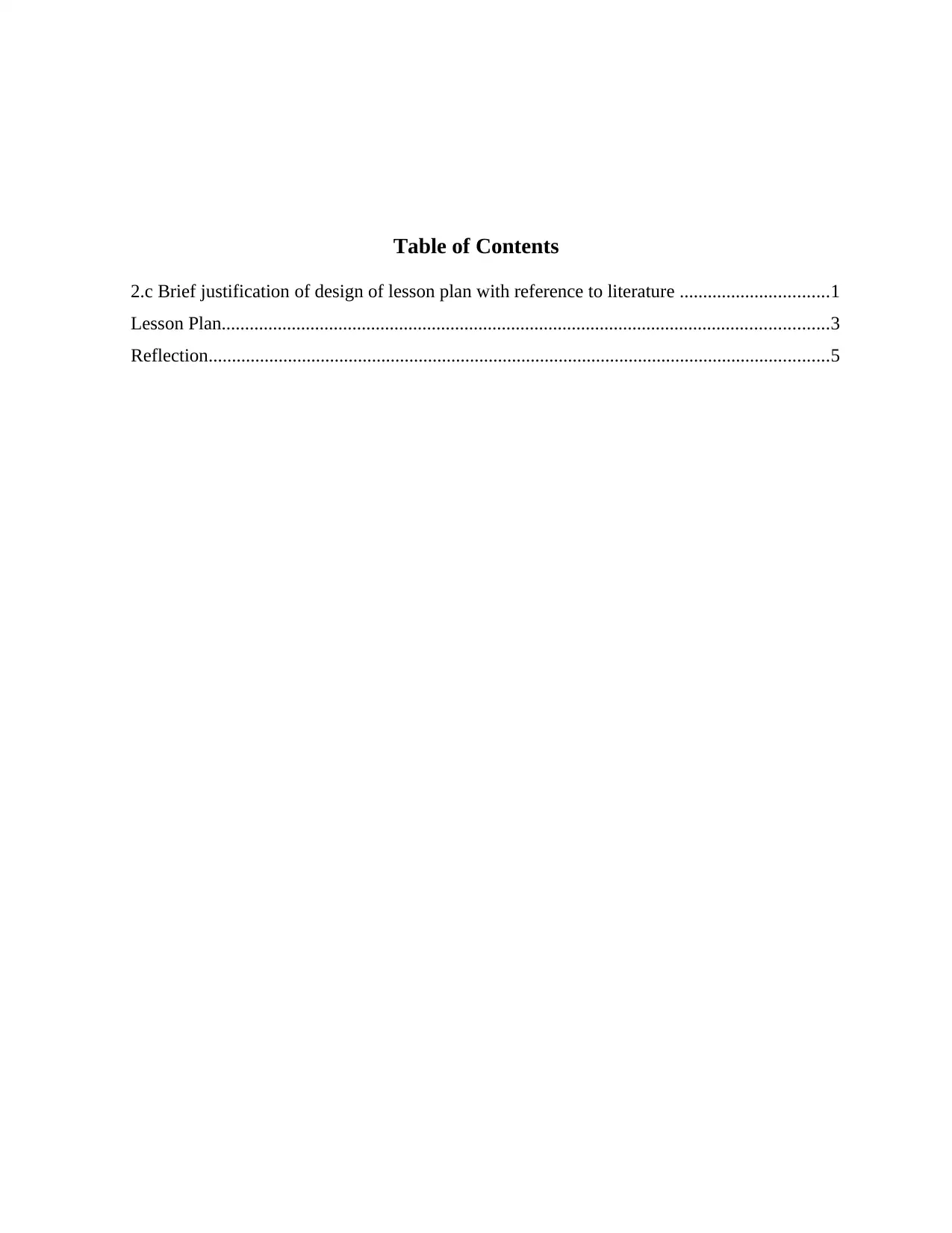
Table of Contents
2.c Brief justification of design of lesson plan with reference to literature ................................1
Lesson Plan..................................................................................................................................3
Reflection.....................................................................................................................................5
2.c Brief justification of design of lesson plan with reference to literature ................................1
Lesson Plan..................................................................................................................................3
Reflection.....................................................................................................................................5
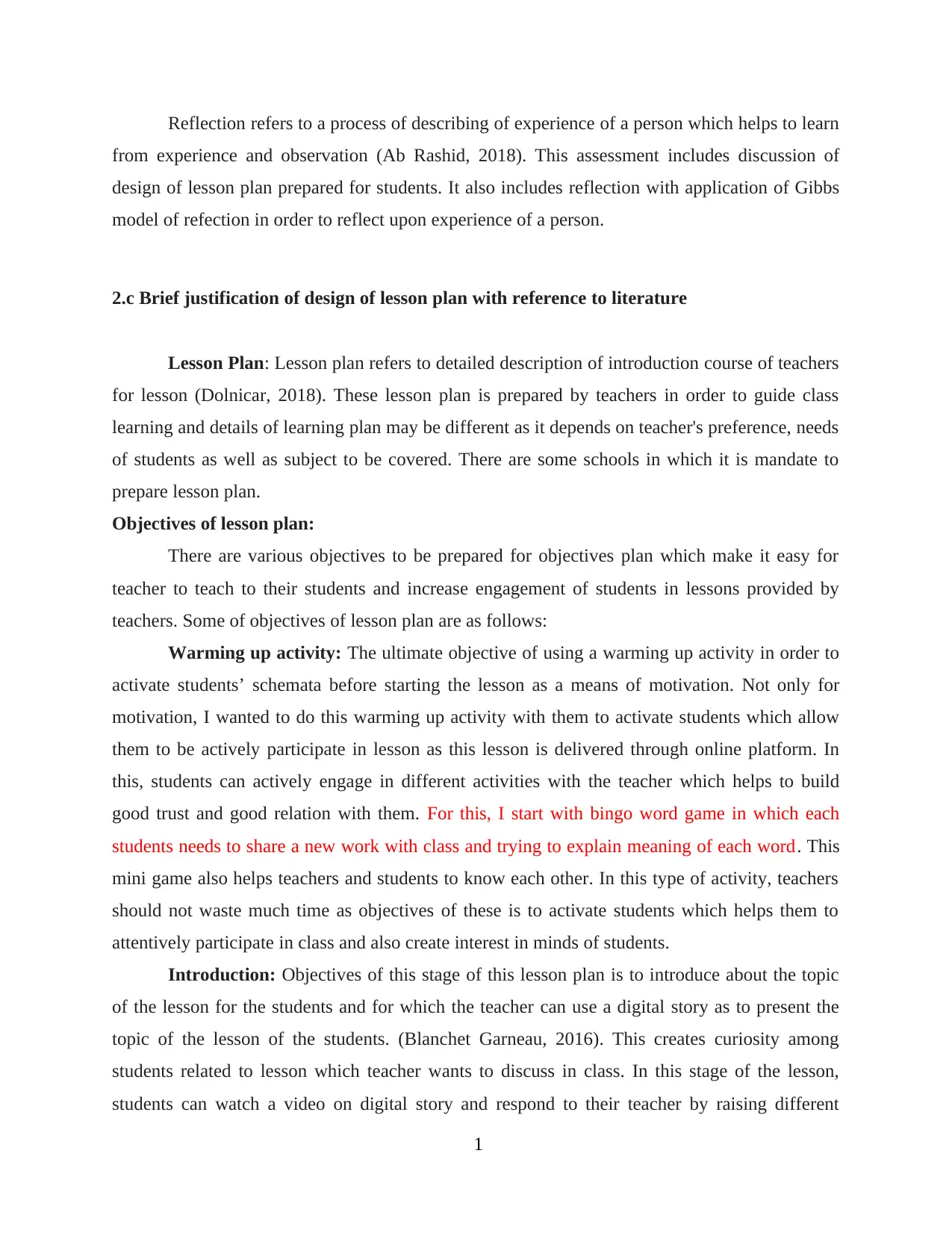
Reflection refers to a process of describing of experience of a person which helps to learn
from experience and observation (Ab Rashid, 2018). This assessment includes discussion of
design of lesson plan prepared for students. It also includes reflection with application of Gibbs
model of refection in order to reflect upon experience of a person.
2.c Brief justification of design of lesson plan with reference to literature
Lesson Plan: Lesson plan refers to detailed description of introduction course of teachers
for lesson (Dolnicar, 2018). These lesson plan is prepared by teachers in order to guide class
learning and details of learning plan may be different as it depends on teacher's preference, needs
of students as well as subject to be covered. There are some schools in which it is mandate to
prepare lesson plan.
Objectives of lesson plan:
There are various objectives to be prepared for objectives plan which make it easy for
teacher to teach to their students and increase engagement of students in lessons provided by
teachers. Some of objectives of lesson plan are as follows:
Warming up activity: The ultimate objective of using a warming up activity in order to
activate students’ schemata before starting the lesson as a means of motivation. Not only for
motivation, I wanted to do this warming up activity with them to activate students which allow
them to be actively participate in lesson as this lesson is delivered through online platform. In
this, students can actively engage in different activities with the teacher which helps to build
good trust and good relation with them. For this, I start with bingo word game in which each
students needs to share a new work with class and trying to explain meaning of each word. This
mini game also helps teachers and students to know each other. In this type of activity, teachers
should not waste much time as objectives of these is to activate students which helps them to
attentively participate in class and also create interest in minds of students.
Introduction: Objectives of this stage of this lesson plan is to introduce about the topic
of the lesson for the students and for which the teacher can use a digital story as to present the
topic of the lesson of the students. (Blanchet Garneau, 2016). This creates curiosity among
students related to lesson which teacher wants to discuss in class. In this stage of the lesson,
students can watch a video on digital story and respond to their teacher by raising different
1
from experience and observation (Ab Rashid, 2018). This assessment includes discussion of
design of lesson plan prepared for students. It also includes reflection with application of Gibbs
model of refection in order to reflect upon experience of a person.
2.c Brief justification of design of lesson plan with reference to literature
Lesson Plan: Lesson plan refers to detailed description of introduction course of teachers
for lesson (Dolnicar, 2018). These lesson plan is prepared by teachers in order to guide class
learning and details of learning plan may be different as it depends on teacher's preference, needs
of students as well as subject to be covered. There are some schools in which it is mandate to
prepare lesson plan.
Objectives of lesson plan:
There are various objectives to be prepared for objectives plan which make it easy for
teacher to teach to their students and increase engagement of students in lessons provided by
teachers. Some of objectives of lesson plan are as follows:
Warming up activity: The ultimate objective of using a warming up activity in order to
activate students’ schemata before starting the lesson as a means of motivation. Not only for
motivation, I wanted to do this warming up activity with them to activate students which allow
them to be actively participate in lesson as this lesson is delivered through online platform. In
this, students can actively engage in different activities with the teacher which helps to build
good trust and good relation with them. For this, I start with bingo word game in which each
students needs to share a new work with class and trying to explain meaning of each word. This
mini game also helps teachers and students to know each other. In this type of activity, teachers
should not waste much time as objectives of these is to activate students which helps them to
attentively participate in class and also create interest in minds of students.
Introduction: Objectives of this stage of this lesson plan is to introduce about the topic
of the lesson for the students and for which the teacher can use a digital story as to present the
topic of the lesson of the students. (Blanchet Garneau, 2016). This creates curiosity among
students related to lesson which teacher wants to discuss in class. In this stage of the lesson,
students can watch a video on digital story and respond to their teacher by raising different
1
⊘ This is a preview!⊘
Do you want full access?
Subscribe today to unlock all pages.

Trusted by 1+ million students worldwide
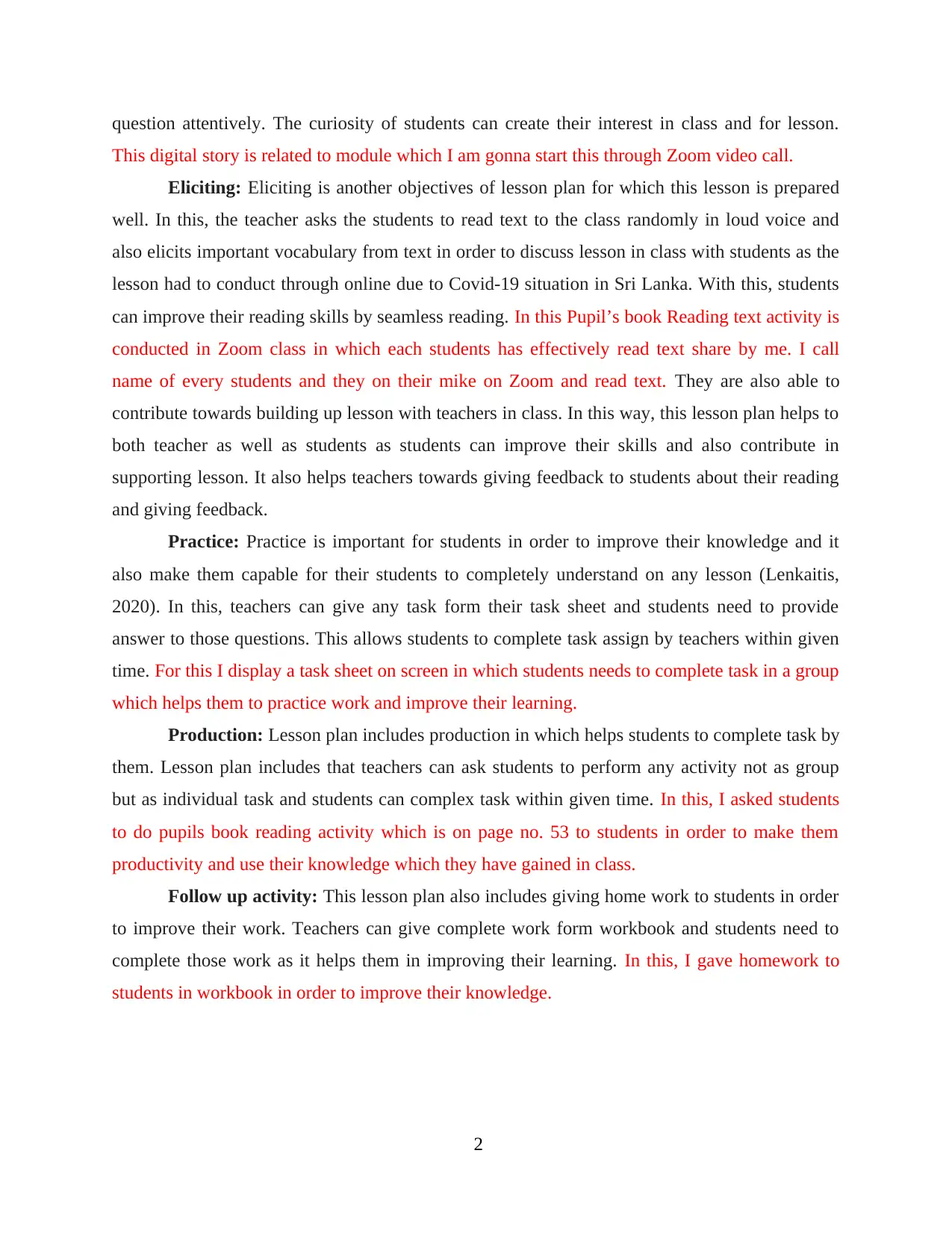
question attentively. The curiosity of students can create their interest in class and for lesson.
This digital story is related to module which I am gonna start this through Zoom video call.
Eliciting: Eliciting is another objectives of lesson plan for which this lesson is prepared
well. In this, the teacher asks the students to read text to the class randomly in loud voice and
also elicits important vocabulary from text in order to discuss lesson in class with students as the
lesson had to conduct through online due to Covid-19 situation in Sri Lanka. With this, students
can improve their reading skills by seamless reading. In this Pupil’s book Reading text activity is
conducted in Zoom class in which each students has effectively read text share by me. I call
name of every students and they on their mike on Zoom and read text. They are also able to
contribute towards building up lesson with teachers in class. In this way, this lesson plan helps to
both teacher as well as students as students can improve their skills and also contribute in
supporting lesson. It also helps teachers towards giving feedback to students about their reading
and giving feedback.
Practice: Practice is important for students in order to improve their knowledge and it
also make them capable for their students to completely understand on any lesson (Lenkaitis,
2020). In this, teachers can give any task form their task sheet and students need to provide
answer to those questions. This allows students to complete task assign by teachers within given
time. For this I display a task sheet on screen in which students needs to complete task in a group
which helps them to practice work and improve their learning.
Production: Lesson plan includes production in which helps students to complete task by
them. Lesson plan includes that teachers can ask students to perform any activity not as group
but as individual task and students can complex task within given time. In this, I asked students
to do pupils book reading activity which is on page no. 53 to students in order to make them
productivity and use their knowledge which they have gained in class.
Follow up activity: This lesson plan also includes giving home work to students in order
to improve their work. Teachers can give complete work form workbook and students need to
complete those work as it helps them in improving their learning. In this, I gave homework to
students in workbook in order to improve their knowledge.
2
This digital story is related to module which I am gonna start this through Zoom video call.
Eliciting: Eliciting is another objectives of lesson plan for which this lesson is prepared
well. In this, the teacher asks the students to read text to the class randomly in loud voice and
also elicits important vocabulary from text in order to discuss lesson in class with students as the
lesson had to conduct through online due to Covid-19 situation in Sri Lanka. With this, students
can improve their reading skills by seamless reading. In this Pupil’s book Reading text activity is
conducted in Zoom class in which each students has effectively read text share by me. I call
name of every students and they on their mike on Zoom and read text. They are also able to
contribute towards building up lesson with teachers in class. In this way, this lesson plan helps to
both teacher as well as students as students can improve their skills and also contribute in
supporting lesson. It also helps teachers towards giving feedback to students about their reading
and giving feedback.
Practice: Practice is important for students in order to improve their knowledge and it
also make them capable for their students to completely understand on any lesson (Lenkaitis,
2020). In this, teachers can give any task form their task sheet and students need to provide
answer to those questions. This allows students to complete task assign by teachers within given
time. For this I display a task sheet on screen in which students needs to complete task in a group
which helps them to practice work and improve their learning.
Production: Lesson plan includes production in which helps students to complete task by
them. Lesson plan includes that teachers can ask students to perform any activity not as group
but as individual task and students can complex task within given time. In this, I asked students
to do pupils book reading activity which is on page no. 53 to students in order to make them
productivity and use their knowledge which they have gained in class.
Follow up activity: This lesson plan also includes giving home work to students in order
to improve their work. Teachers can give complete work form workbook and students need to
complete those work as it helps them in improving their learning. In this, I gave homework to
students in workbook in order to improve their knowledge.
2
Paraphrase This Document
Need a fresh take? Get an instant paraphrase of this document with our AI Paraphraser
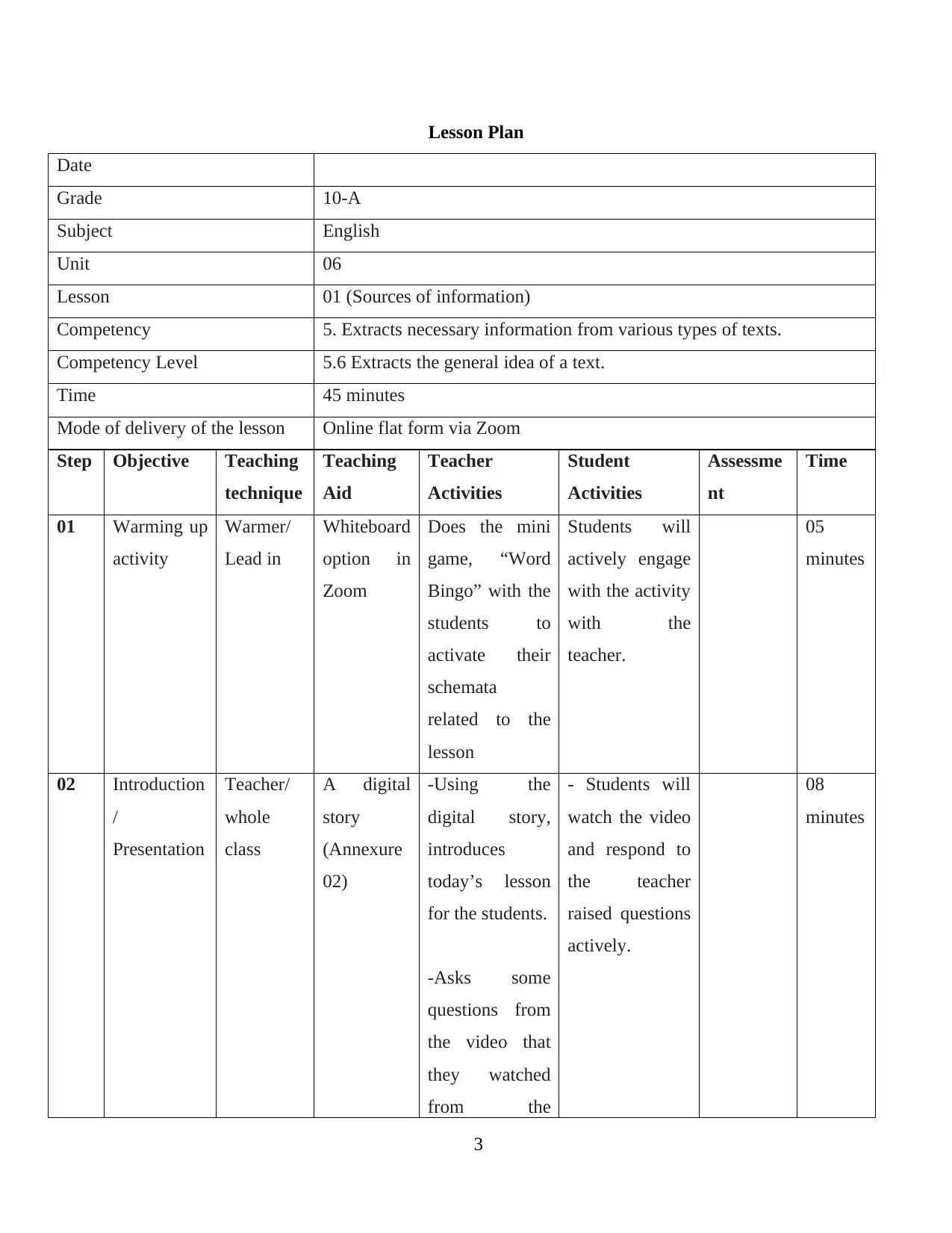
Lesson Plan
Date
Grade 10-A
Subject English
Unit 06
Lesson 01 (Sources of information)
Competency 5. Extracts necessary information from various types of texts.
Competency Level 5.6 Extracts the general idea of a text.
Time 45 minutes
Mode of delivery of the lesson Online flat form via Zoom
Step Objective Teaching
technique
Teaching
Aid
Teacher
Activities
Student
Activities
Assessme
nt
Time
01 Warming up
activity
Warmer/
Lead in
Whiteboard
option in
Zoom
Does the mini
game, “Word
Bingo” with the
students to
activate their
schemata
related to the
lesson
Students will
actively engage
with the activity
with the
teacher.
05
minutes
02 Introduction
/
Presentation
Teacher/
whole
class
A digital
story
(Annexure
02)
-Using the
digital story,
introduces
today’s lesson
for the students.
-Asks some
questions from
the video that
they watched
from the
- Students will
watch the video
and respond to
the teacher
raised questions
actively.
08
minutes
3
Date
Grade 10-A
Subject English
Unit 06
Lesson 01 (Sources of information)
Competency 5. Extracts necessary information from various types of texts.
Competency Level 5.6 Extracts the general idea of a text.
Time 45 minutes
Mode of delivery of the lesson Online flat form via Zoom
Step Objective Teaching
technique
Teaching
Aid
Teacher
Activities
Student
Activities
Assessme
nt
Time
01 Warming up
activity
Warmer/
Lead in
Whiteboard
option in
Zoom
Does the mini
game, “Word
Bingo” with the
students to
activate their
schemata
related to the
lesson
Students will
actively engage
with the activity
with the
teacher.
05
minutes
02 Introduction
/
Presentation
Teacher/
whole
class
A digital
story
(Annexure
02)
-Using the
digital story,
introduces
today’s lesson
for the students.
-Asks some
questions from
the video that
they watched
from the
- Students will
watch the video
and respond to
the teacher
raised questions
actively.
08
minutes
3
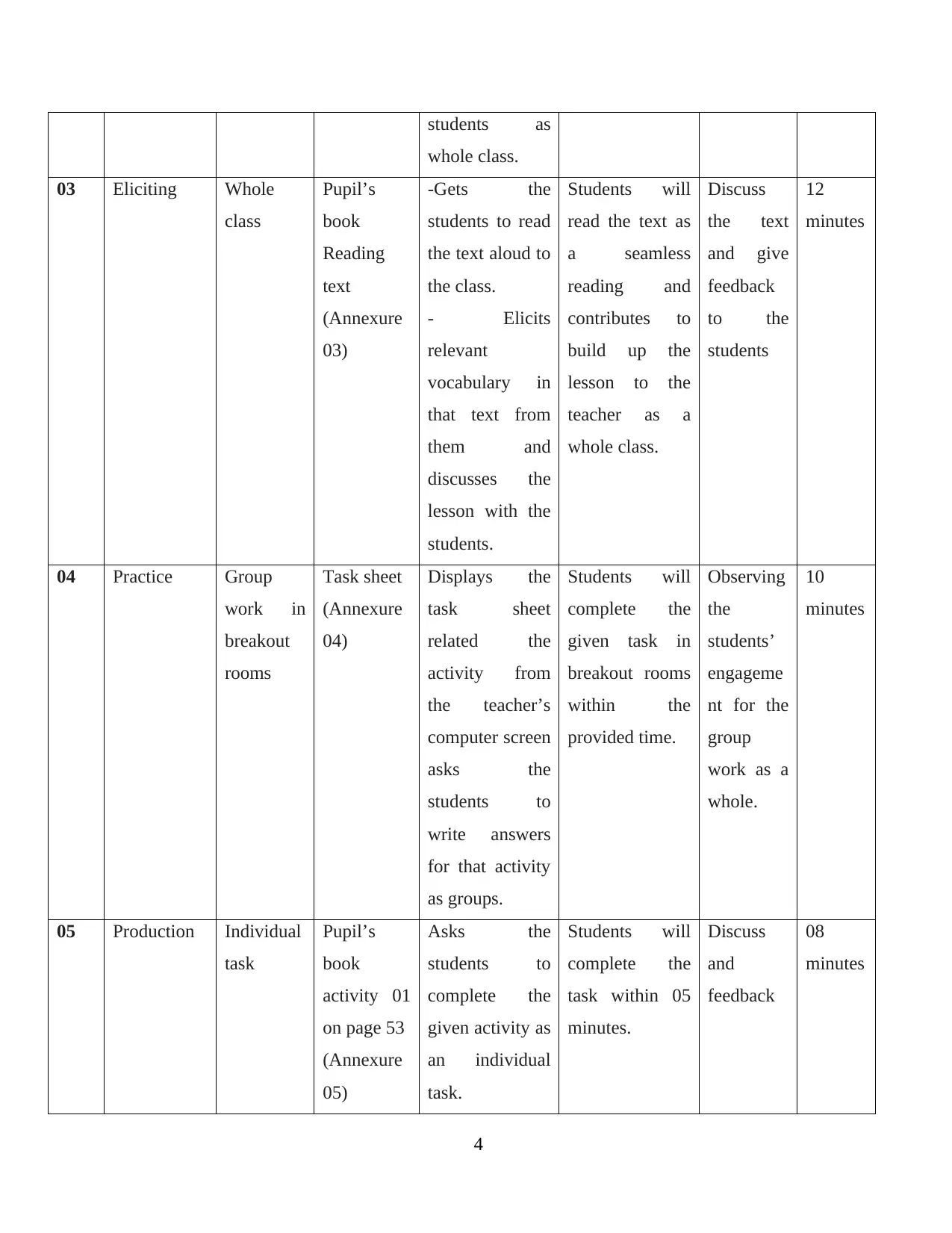
students as
whole class.
03 Eliciting Whole
class
Pupil’s
book
Reading
text
(Annexure
03)
-Gets the
students to read
the text aloud to
the class.
- Elicits
relevant
vocabulary in
that text from
them and
discusses the
lesson with the
students.
Students will
read the text as
a seamless
reading and
contributes to
build up the
lesson to the
teacher as a
whole class.
Discuss
the text
and give
feedback
to the
students
12
minutes
04 Practice Group
work in
breakout
rooms
Task sheet
(Annexure
04)
Displays the
task sheet
related the
activity from
the teacher’s
computer screen
asks the
students to
write answers
for that activity
as groups.
Students will
complete the
given task in
breakout rooms
within the
provided time.
Observing
the
students’
engageme
nt for the
group
work as a
whole.
10
minutes
05 Production Individual
task
Pupil’s
book
activity 01
on page 53
(Annexure
05)
Asks the
students to
complete the
given activity as
an individual
task.
Students will
complete the
task within 05
minutes.
Discuss
and
feedback
08
minutes
4
whole class.
03 Eliciting Whole
class
Pupil’s
book
Reading
text
(Annexure
03)
-Gets the
students to read
the text aloud to
the class.
- Elicits
relevant
vocabulary in
that text from
them and
discusses the
lesson with the
students.
Students will
read the text as
a seamless
reading and
contributes to
build up the
lesson to the
teacher as a
whole class.
Discuss
the text
and give
feedback
to the
students
12
minutes
04 Practice Group
work in
breakout
rooms
Task sheet
(Annexure
04)
Displays the
task sheet
related the
activity from
the teacher’s
computer screen
asks the
students to
write answers
for that activity
as groups.
Students will
complete the
given task in
breakout rooms
within the
provided time.
Observing
the
students’
engageme
nt for the
group
work as a
whole.
10
minutes
05 Production Individual
task
Pupil’s
book
activity 01
on page 53
(Annexure
05)
Asks the
students to
complete the
given activity as
an individual
task.
Students will
complete the
task within 05
minutes.
Discuss
and
feedback
08
minutes
4
⊘ This is a preview!⊘
Do you want full access?
Subscribe today to unlock all pages.

Trusted by 1+ million students worldwide
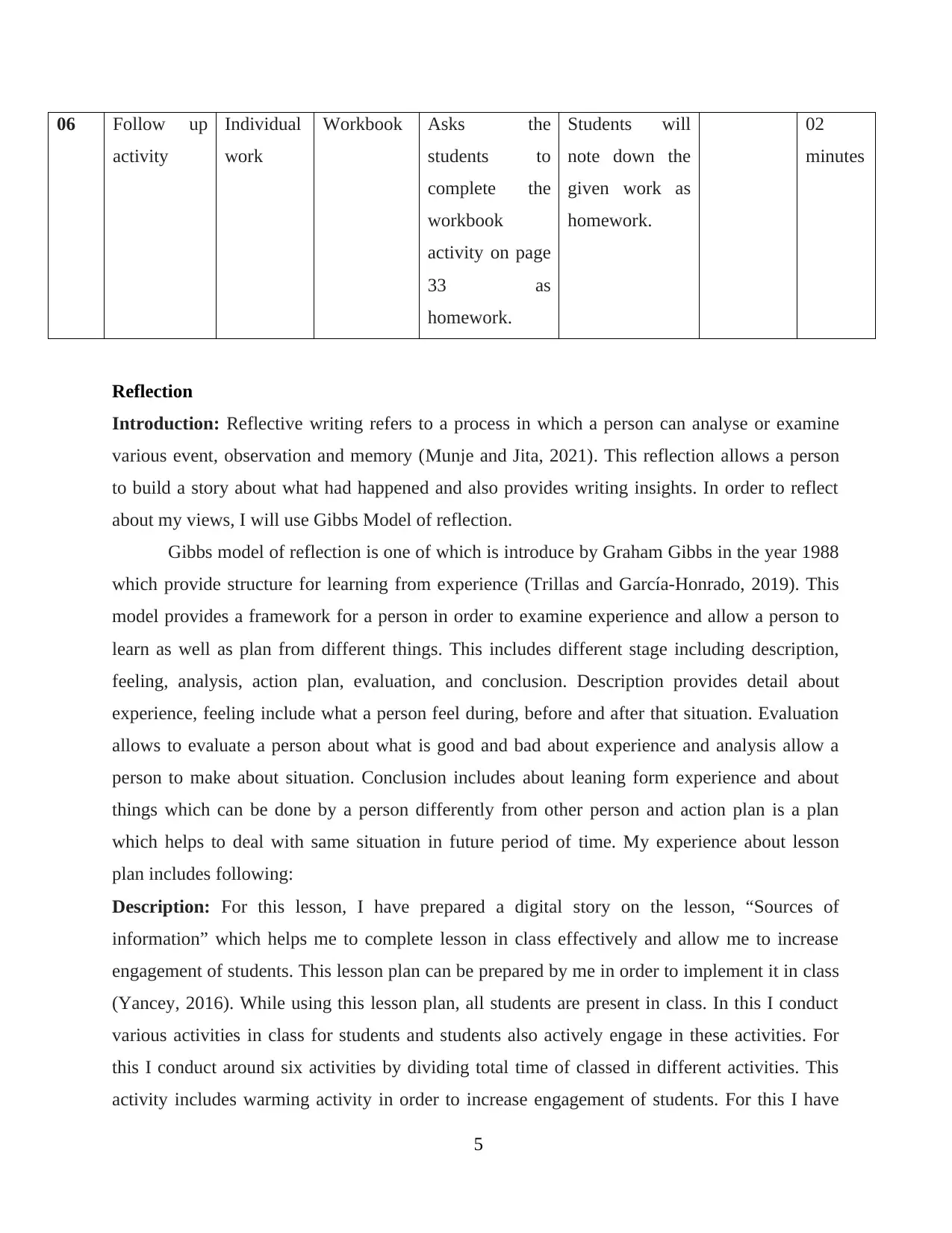
06 Follow up
activity
Individual
work
Workbook Asks the
students to
complete the
workbook
activity on page
33 as
homework.
Students will
note down the
given work as
homework.
02
minutes
Reflection
Introduction: Reflective writing refers to a process in which a person can analyse or examine
various event, observation and memory (Munje and Jita, 2021). This reflection allows a person
to build a story about what had happened and also provides writing insights. In order to reflect
about my views, I will use Gibbs Model of reflection.
Gibbs model of reflection is one of which is introduce by Graham Gibbs in the year 1988
which provide structure for learning from experience (Trillas and García-Honrado, 2019). This
model provides a framework for a person in order to examine experience and allow a person to
learn as well as plan from different things. This includes different stage including description,
feeling, analysis, action plan, evaluation, and conclusion. Description provides detail about
experience, feeling include what a person feel during, before and after that situation. Evaluation
allows to evaluate a person about what is good and bad about experience and analysis allow a
person to make about situation. Conclusion includes about leaning form experience and about
things which can be done by a person differently from other person and action plan is a plan
which helps to deal with same situation in future period of time. My experience about lesson
plan includes following:
Description: For this lesson, I have prepared a digital story on the lesson, “Sources of
information” which helps me to complete lesson in class effectively and allow me to increase
engagement of students. This lesson plan can be prepared by me in order to implement it in class
(Yancey, 2016). While using this lesson plan, all students are present in class. In this I conduct
various activities in class for students and students also actively engage in these activities. For
this I conduct around six activities by dividing total time of classed in different activities. This
activity includes warming activity in order to increase engagement of students. For this I have
5
activity
Individual
work
Workbook Asks the
students to
complete the
workbook
activity on page
33 as
homework.
Students will
note down the
given work as
homework.
02
minutes
Reflection
Introduction: Reflective writing refers to a process in which a person can analyse or examine
various event, observation and memory (Munje and Jita, 2021). This reflection allows a person
to build a story about what had happened and also provides writing insights. In order to reflect
about my views, I will use Gibbs Model of reflection.
Gibbs model of reflection is one of which is introduce by Graham Gibbs in the year 1988
which provide structure for learning from experience (Trillas and García-Honrado, 2019). This
model provides a framework for a person in order to examine experience and allow a person to
learn as well as plan from different things. This includes different stage including description,
feeling, analysis, action plan, evaluation, and conclusion. Description provides detail about
experience, feeling include what a person feel during, before and after that situation. Evaluation
allows to evaluate a person about what is good and bad about experience and analysis allow a
person to make about situation. Conclusion includes about leaning form experience and about
things which can be done by a person differently from other person and action plan is a plan
which helps to deal with same situation in future period of time. My experience about lesson
plan includes following:
Description: For this lesson, I have prepared a digital story on the lesson, “Sources of
information” which helps me to complete lesson in class effectively and allow me to increase
engagement of students. This lesson plan can be prepared by me in order to implement it in class
(Yancey, 2016). While using this lesson plan, all students are present in class. In this I conduct
various activities in class for students and students also actively engage in these activities. For
this I conduct around six activities by dividing total time of classed in different activities. This
activity includes warming activity in order to increase engagement of students. For this I have
5
Paraphrase This Document
Need a fresh take? Get an instant paraphrase of this document with our AI Paraphraser
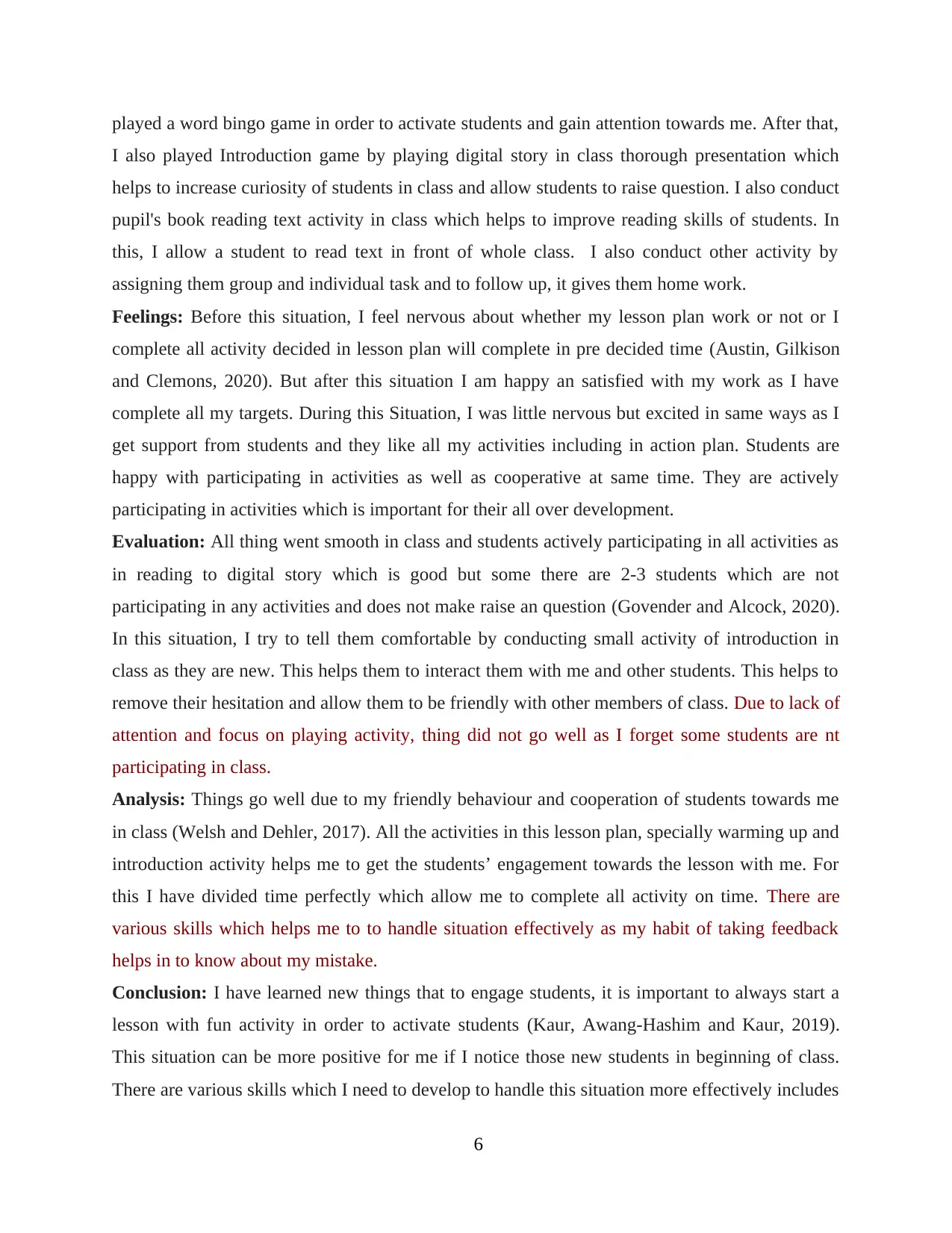
played a word bingo game in order to activate students and gain attention towards me. After that,
I also played Introduction game by playing digital story in class thorough presentation which
helps to increase curiosity of students in class and allow students to raise question. I also conduct
pupil's book reading text activity in class which helps to improve reading skills of students. In
this, I allow a student to read text in front of whole class. I also conduct other activity by
assigning them group and individual task and to follow up, it gives them home work.
Feelings: Before this situation, I feel nervous about whether my lesson plan work or not or I
complete all activity decided in lesson plan will complete in pre decided time (Austin, Gilkison
and Clemons, 2020). But after this situation I am happy an satisfied with my work as I have
complete all my targets. During this Situation, I was little nervous but excited in same ways as I
get support from students and they like all my activities including in action plan. Students are
happy with participating in activities as well as cooperative at same time. They are actively
participating in activities which is important for their all over development.
Evaluation: All thing went smooth in class and students actively participating in all activities as
in reading to digital story which is good but some there are 2-3 students which are not
participating in any activities and does not make raise an question (Govender and Alcock, 2020).
In this situation, I try to tell them comfortable by conducting small activity of introduction in
class as they are new. This helps them to interact them with me and other students. This helps to
remove their hesitation and allow them to be friendly with other members of class. Due to lack of
attention and focus on playing activity, thing did not go well as I forget some students are nt
participating in class.
Analysis: Things go well due to my friendly behaviour and cooperation of students towards me
in class (Welsh and Dehler, 2017). All the activities in this lesson plan, specially warming up and
introduction activity helps me to get the students’ engagement towards the lesson with me. For
this I have divided time perfectly which allow me to complete all activity on time. There are
various skills which helps me to to handle situation effectively as my habit of taking feedback
helps in to know about my mistake.
Conclusion: I have learned new things that to engage students, it is important to always start a
lesson with fun activity in order to activate students (Kaur, Awang-Hashim and Kaur, 2019).
This situation can be more positive for me if I notice those new students in beginning of class.
There are various skills which I need to develop to handle this situation more effectively includes
6
I also played Introduction game by playing digital story in class thorough presentation which
helps to increase curiosity of students in class and allow students to raise question. I also conduct
pupil's book reading text activity in class which helps to improve reading skills of students. In
this, I allow a student to read text in front of whole class. I also conduct other activity by
assigning them group and individual task and to follow up, it gives them home work.
Feelings: Before this situation, I feel nervous about whether my lesson plan work or not or I
complete all activity decided in lesson plan will complete in pre decided time (Austin, Gilkison
and Clemons, 2020). But after this situation I am happy an satisfied with my work as I have
complete all my targets. During this Situation, I was little nervous but excited in same ways as I
get support from students and they like all my activities including in action plan. Students are
happy with participating in activities as well as cooperative at same time. They are actively
participating in activities which is important for their all over development.
Evaluation: All thing went smooth in class and students actively participating in all activities as
in reading to digital story which is good but some there are 2-3 students which are not
participating in any activities and does not make raise an question (Govender and Alcock, 2020).
In this situation, I try to tell them comfortable by conducting small activity of introduction in
class as they are new. This helps them to interact them with me and other students. This helps to
remove their hesitation and allow them to be friendly with other members of class. Due to lack of
attention and focus on playing activity, thing did not go well as I forget some students are nt
participating in class.
Analysis: Things go well due to my friendly behaviour and cooperation of students towards me
in class (Welsh and Dehler, 2017). All the activities in this lesson plan, specially warming up and
introduction activity helps me to get the students’ engagement towards the lesson with me. For
this I have divided time perfectly which allow me to complete all activity on time. There are
various skills which helps me to to handle situation effectively as my habit of taking feedback
helps in to know about my mistake.
Conclusion: I have learned new things that to engage students, it is important to always start a
lesson with fun activity in order to activate students (Kaur, Awang-Hashim and Kaur, 2019).
This situation can be more positive for me if I notice those new students in beginning of class.
There are various skills which I need to develop to handle this situation more effectively includes
6
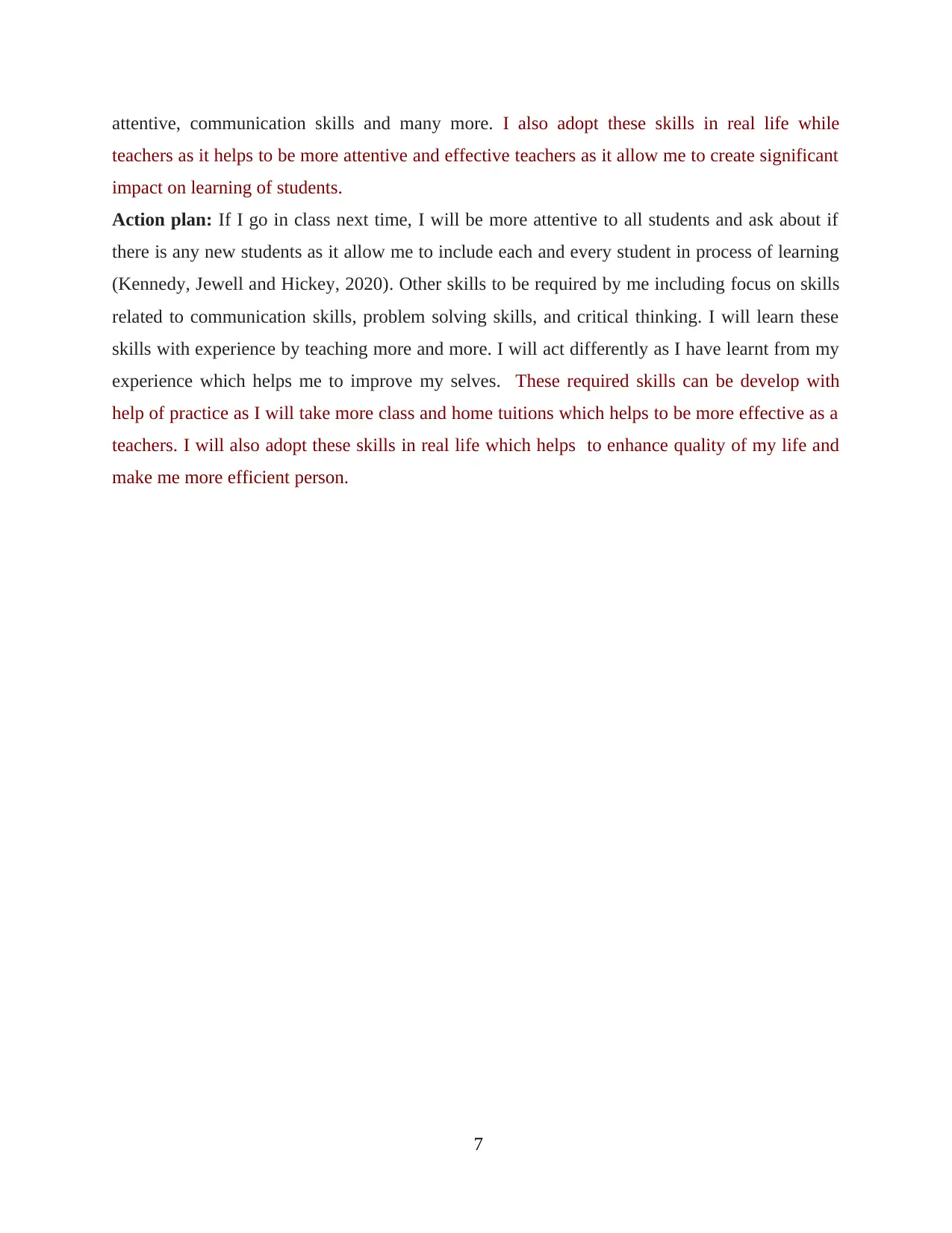
attentive, communication skills and many more. I also adopt these skills in real life while
teachers as it helps to be more attentive and effective teachers as it allow me to create significant
impact on learning of students.
Action plan: If I go in class next time, I will be more attentive to all students and ask about if
there is any new students as it allow me to include each and every student in process of learning
(Kennedy, Jewell and Hickey, 2020). Other skills to be required by me including focus on skills
related to communication skills, problem solving skills, and critical thinking. I will learn these
skills with experience by teaching more and more. I will act differently as I have learnt from my
experience which helps me to improve my selves. These required skills can be develop with
help of practice as I will take more class and home tuitions which helps to be more effective as a
teachers. I will also adopt these skills in real life which helps to enhance quality of my life and
make me more efficient person.
7
teachers as it helps to be more attentive and effective teachers as it allow me to create significant
impact on learning of students.
Action plan: If I go in class next time, I will be more attentive to all students and ask about if
there is any new students as it allow me to include each and every student in process of learning
(Kennedy, Jewell and Hickey, 2020). Other skills to be required by me including focus on skills
related to communication skills, problem solving skills, and critical thinking. I will learn these
skills with experience by teaching more and more. I will act differently as I have learnt from my
experience which helps me to improve my selves. These required skills can be develop with
help of practice as I will take more class and home tuitions which helps to be more effective as a
teachers. I will also adopt these skills in real life which helps to enhance quality of my life and
make me more efficient person.
7
⊘ This is a preview!⊘
Do you want full access?
Subscribe today to unlock all pages.

Trusted by 1+ million students worldwide
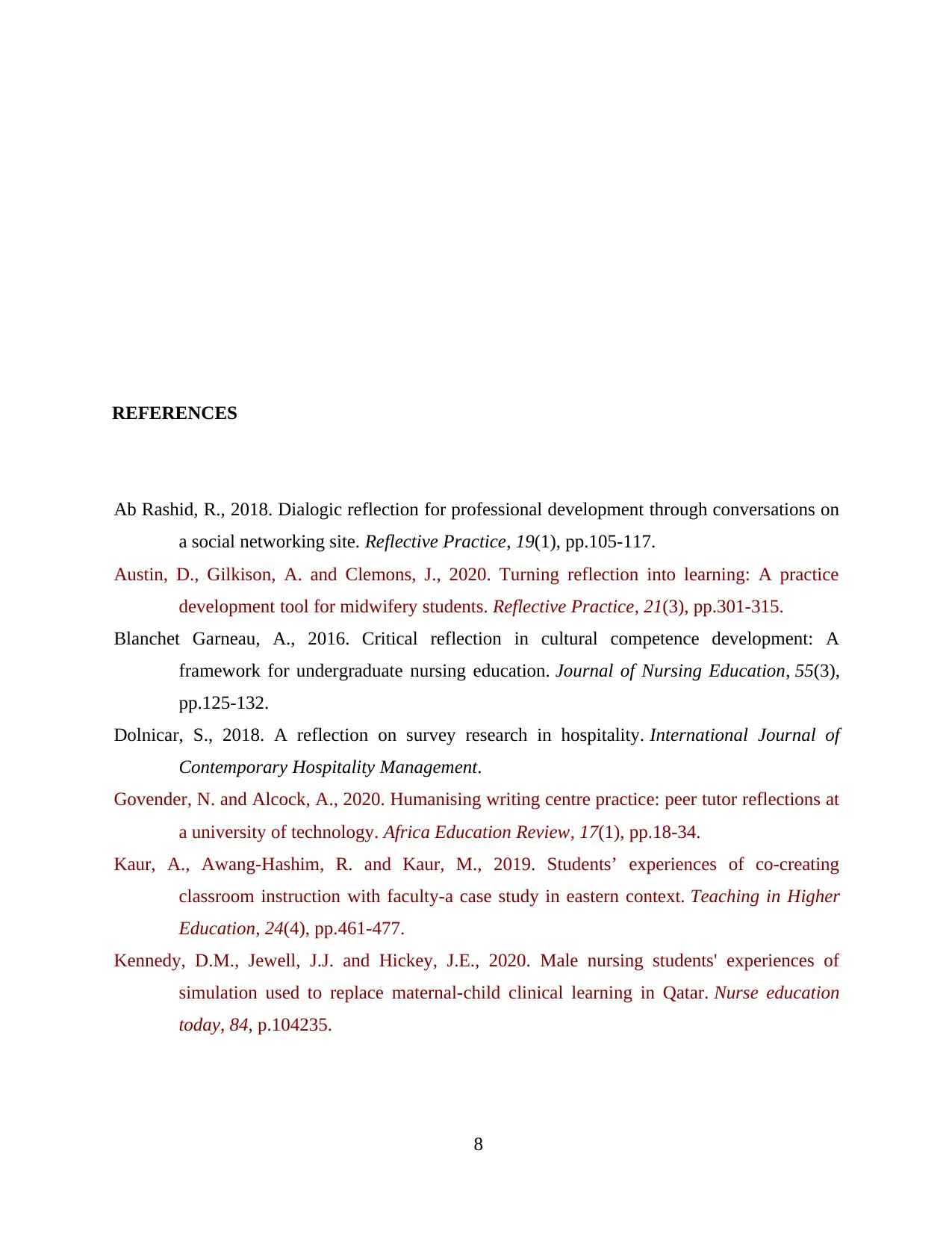
REFERENCES
Ab Rashid, R., 2018. Dialogic reflection for professional development through conversations on
a social networking site. Reflective Practice, 19(1), pp.105-117.
Austin, D., Gilkison, A. and Clemons, J., 2020. Turning reflection into learning: A practice
development tool for midwifery students. Reflective Practice, 21(3), pp.301-315.
Blanchet Garneau, A., 2016. Critical reflection in cultural competence development: A
framework for undergraduate nursing education. Journal of Nursing Education, 55(3),
pp.125-132.
Dolnicar, S., 2018. A reflection on survey research in hospitality. International Journal of
Contemporary Hospitality Management.
Govender, N. and Alcock, A., 2020. Humanising writing centre practice: peer tutor reflections at
a university of technology. Africa Education Review, 17(1), pp.18-34.
Kaur, A., Awang-Hashim, R. and Kaur, M., 2019. Students’ experiences of co-creating
classroom instruction with faculty-a case study in eastern context. Teaching in Higher
Education, 24(4), pp.461-477.
Kennedy, D.M., Jewell, J.J. and Hickey, J.E., 2020. Male nursing students' experiences of
simulation used to replace maternal-child clinical learning in Qatar. Nurse education
today, 84, p.104235.
8
Ab Rashid, R., 2018. Dialogic reflection for professional development through conversations on
a social networking site. Reflective Practice, 19(1), pp.105-117.
Austin, D., Gilkison, A. and Clemons, J., 2020. Turning reflection into learning: A practice
development tool for midwifery students. Reflective Practice, 21(3), pp.301-315.
Blanchet Garneau, A., 2016. Critical reflection in cultural competence development: A
framework for undergraduate nursing education. Journal of Nursing Education, 55(3),
pp.125-132.
Dolnicar, S., 2018. A reflection on survey research in hospitality. International Journal of
Contemporary Hospitality Management.
Govender, N. and Alcock, A., 2020. Humanising writing centre practice: peer tutor reflections at
a university of technology. Africa Education Review, 17(1), pp.18-34.
Kaur, A., Awang-Hashim, R. and Kaur, M., 2019. Students’ experiences of co-creating
classroom instruction with faculty-a case study in eastern context. Teaching in Higher
Education, 24(4), pp.461-477.
Kennedy, D.M., Jewell, J.J. and Hickey, J.E., 2020. Male nursing students' experiences of
simulation used to replace maternal-child clinical learning in Qatar. Nurse education
today, 84, p.104235.
8
Paraphrase This Document
Need a fresh take? Get an instant paraphrase of this document with our AI Paraphraser
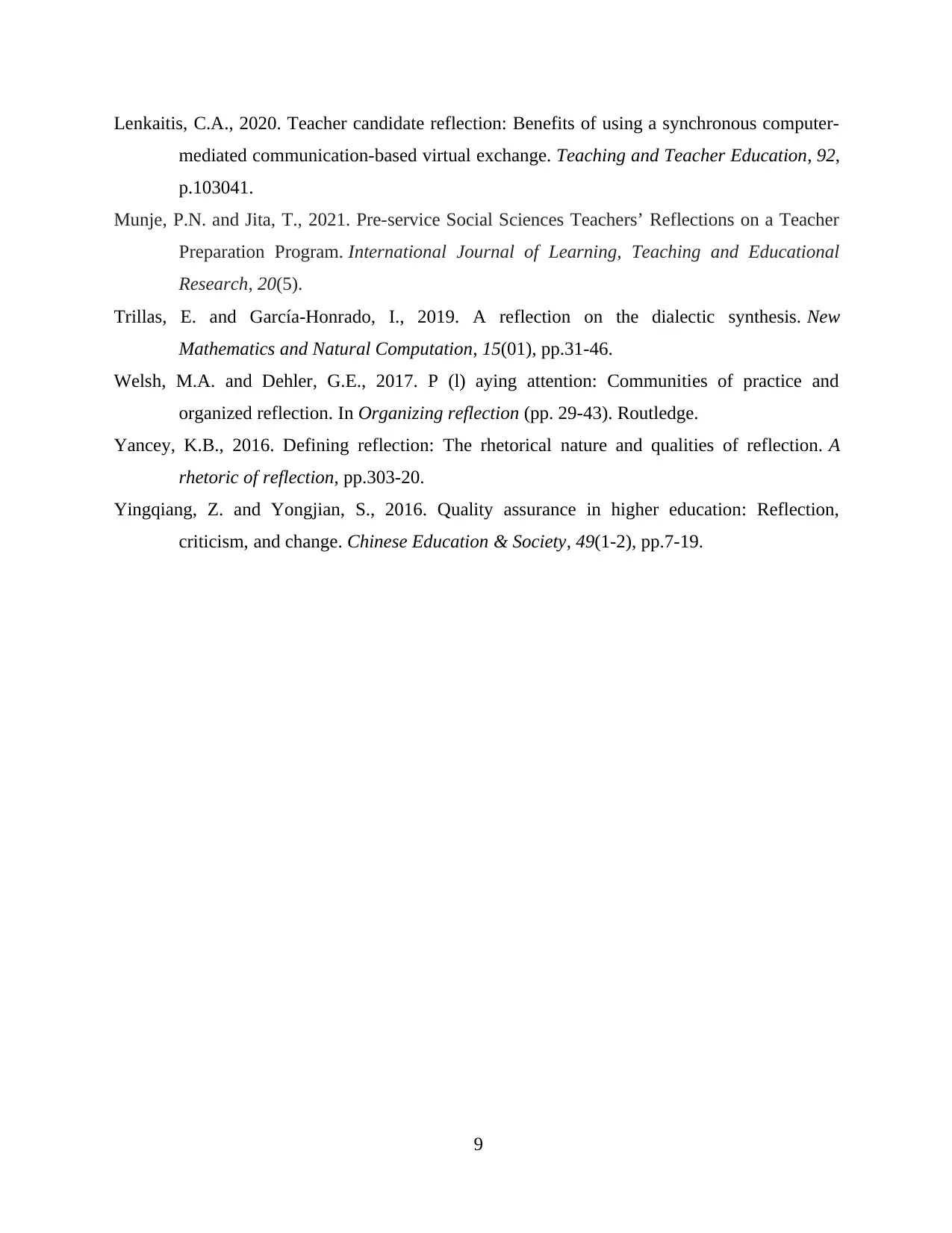
Lenkaitis, C.A., 2020. Teacher candidate reflection: Benefits of using a synchronous computer-
mediated communication-based virtual exchange. Teaching and Teacher Education, 92,
p.103041.
Munje, P.N. and Jita, T., 2021. Pre-service Social Sciences Teachers’ Reflections on a Teacher
Preparation Program. International Journal of Learning, Teaching and Educational
Research, 20(5).
Trillas, E. and García-Honrado, I., 2019. A reflection on the dialectic synthesis. New
Mathematics and Natural Computation, 15(01), pp.31-46.
Welsh, M.A. and Dehler, G.E., 2017. P (l) aying attention: Communities of practice and
organized reflection. In Organizing reflection (pp. 29-43). Routledge.
Yancey, K.B., 2016. Defining reflection: The rhetorical nature and qualities of reflection. A
rhetoric of reflection, pp.303-20.
Yingqiang, Z. and Yongjian, S., 2016. Quality assurance in higher education: Reflection,
criticism, and change. Chinese Education & Society, 49(1-2), pp.7-19.
9
mediated communication-based virtual exchange. Teaching and Teacher Education, 92,
p.103041.
Munje, P.N. and Jita, T., 2021. Pre-service Social Sciences Teachers’ Reflections on a Teacher
Preparation Program. International Journal of Learning, Teaching and Educational
Research, 20(5).
Trillas, E. and García-Honrado, I., 2019. A reflection on the dialectic synthesis. New
Mathematics and Natural Computation, 15(01), pp.31-46.
Welsh, M.A. and Dehler, G.E., 2017. P (l) aying attention: Communities of practice and
organized reflection. In Organizing reflection (pp. 29-43). Routledge.
Yancey, K.B., 2016. Defining reflection: The rhetorical nature and qualities of reflection. A
rhetoric of reflection, pp.303-20.
Yingqiang, Z. and Yongjian, S., 2016. Quality assurance in higher education: Reflection,
criticism, and change. Chinese Education & Society, 49(1-2), pp.7-19.
9
1 out of 11
Related Documents
Your All-in-One AI-Powered Toolkit for Academic Success.
+13062052269
info@desklib.com
Available 24*7 on WhatsApp / Email
![[object Object]](/_next/static/media/star-bottom.7253800d.svg)
Unlock your academic potential
Copyright © 2020–2025 A2Z Services. All Rights Reserved. Developed and managed by ZUCOL.




